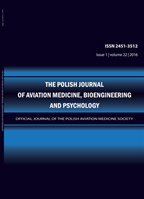2021, Volume 27, Issue 2
HOW DOES MENTAL DISTRACTION INDUCED BY AN ADDITIONAL TASK AFFECT THE SEVERITY OF SIMULATOR SICKNESS SYMPTOMS IN PILOTS: A SPATIAL DISORIENTATION SIMULATOR STUDY
RAFAŁ LEWKOWICZ1, BIBIANNA BAŁAJ2, AGNIESZKA FUDALI-CZYŻ3, PAWEŁ STRÓŻAK3, PAWEŁ AUGUSTYNOWICZ3, PIOTR FRANCUZ3
-------------------------------------------------------------------------------------------------
1Simulator Study and Aeromedical Training Division, Military Institute of Aviation Medicine
2Faculty of Humanities, Nicolaus Copernicus University
3Faculty of Social Sciences, Institute of Psychology, John Paul II Catholic University of Lublin
Autor korenspondencyjny: RAFAŁ LEWKOWICZ; Simulator Study and Aeromedical Training Division, Military Institute of Aviation Medicine; email: rlewkowicz@wiml.waw.pl
Full text
Streszczenie
Introduction: To improve the effectiveness of spatial disorientation (SD) training in a flight simulator, pilots are recommended to perform an additional task that induces a mental distraction. The presented study explored how the inclusion of an additional task that may enhance the effectiveness of SD training changes the severity of simulator sickness symptoms reported after exposure in the Gyro-IPT simulator.
Methods: We compared the incidence of simulator sickness symptoms in pilots across four setups of flight scenarios (varying according to cognitive load distraction) collected during our previous studies. A total of 77 male military pilots (age 28.3±6.2) with flight experience (810.72 ±969.43 hours) were randomly assigned to one of four groups and then exposed to a 60-min long flight session (12 flight profiles, six involved an SD-conflict) with active control in the Gyro IPT simulator. In addition to the primary flying task, in three flight scenarios, pilots were asked to perform an additional visual (a change detection flicker task [CDFT]), auditory (an auditory N-back task [NBT]), or duration-discrimination task (DDT)). To measure simulator sickness symptoms, the Simulator Sickness Questionnaire (SSQ) was administered pre- and post-simulator exposure.
Results: The severity of simulator sickness symptoms due to visual and motion cues did not significantly change when the pilot performed a non-sickening cognitive task (additional visual or auditory task). The total SSQ score and scores for nausea, oculomotor disturbance, and disorientation in the CDFT and DDT were slightly higher than in the control condition (flight without additional task). Despite the observed differences, according to the SSQ scoring criteria, the simulator sickness symptoms reported by the pilots were negligible.
Conclusions: The additional tasks (CDFT, auditory NBT, or DDT) applied to improve the effectiveness of SD training in the Gyro-IPT simulator do not significantly change unwanted effects, such as simulator sickness.
Słowa kluczowe
simulator sickness, motion sickness, flight simulator, spatial disorientation, expertise, cognitive load
